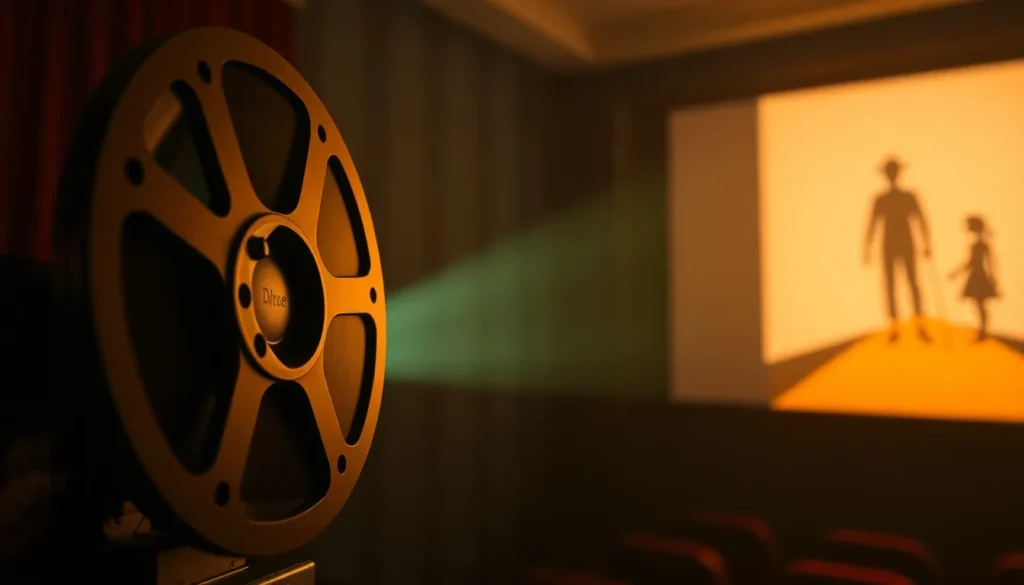Table of Contents
ToggleMovies aren’t just a way to escape reality; they’re a treasure trove of hidden meanings waiting to be uncovered. From the flickering lights of a projector to the last dramatic twist, filmmakers sprinkle symbolism like confetti at a parade. Whether it’s a red balloon floating ominously or a character’s obsession with a ticking clock, these symbols add layers of depth that can leave audiences pondering long after the credits roll.
Understanding movie symbolism can transform a casual viewer into a cinematic sleuth. It’s like being handed a secret decoder ring that reveals what’s really going on beneath the surface. So grab your popcorn and get ready to dive into the world of visual metaphors, where every frame tells a story and nothing is ever quite what it seems. After all, who doesn’t want to impress friends with their newfound ability to spot a metaphorical unicorn in a sea of ordinary horses?
Understanding Movie Symbolism
Movie symbolism involves the use of visual metaphors and hidden meanings within films. Recognizing these symbols significantly enhances the audience’s experience and interpretation of the narrative.
Definition of Movie Symbolism
Movie symbolism refers to the deeper meanings attached to specific objects, colors, or actions within a film. Filmmakers often implement these elements to convey complex themes or emotions without explicit explanation. Examples include a character’s recurring motif, such as a red dress symbolizing passion or danger. This layering of meaning provides audiences with a richer understanding of the narrative, allowing for a more engaging viewing experience.
Importance in Film Analysis
Understanding movie symbolism plays a crucial role in film analysis. Analyzing symbols reveals underlying themes and character motivations, enriching the overall interpretation of the film. Exploring these details encourages viewers to look beyond the surface, fostering a deeper connection to the story. Effective symbolism often facilitates discussions around cultural or societal issues, further broadening the film’s impact. Engaging with these elements allows viewers to appreciate cinematic artistry while sharpening their analytical skills.
Common Types of Symbols in Movies

Filmmakers employ various symbols to convey deeper meanings. Understanding these symbols heightens the viewing experience and fosters insightful discussions.
Visual Symbols
Visual symbols consist of objects, colors, or landscapes that represent themes or emotions. A red rose often signifies love, while a darkened sky may evoke foreboding. Filmmakers meticulously design visual elements to enhance narrative depth. For example, in The Great Gatsby, the green light symbolizes the unattainable dreams of the characters. Each scene contains layers of meaning, inviting viewers to look closer at the visuals presented. An audience that recognizes these symbols can appreciate the film’s artistry in new ways. The effectiveness of visual symbolism lies in its ability to communicate without words, often making emotional connections instant and profound.
Auditory Symbols
Auditory symbols include sounds, music, and dialogue that contribute to the film’s atmosphere. A haunting melody can evoke sadness, while upbeat tempos create excitement. For instance, the iconic score in Jaws signals impending danger, sharpening tension in key moments. Using specific tones or instruments can subtly influence a viewer’s emotional response. The connection between sounds and emotions enhances storytelling, drawing audiences deeper into the narrative. Recognizing auditory symbols allows viewers to appreciate the craft behind sound design. It creates a more immersive experience, heightening engagement with the film’s themes and characters.
Analyzing Movie Symbolism
Understanding movie symbolism requires delving into various layers of meaning that filmmakers embed in their work. This exploration greatly enriches the viewing experience.
Contextual Interpretation
Contextual interpretation focuses on how specific symbols resonate within a film’s narrative. Filmmakers strategically position elements to convey deeper meanings shaped by the story’s setting and character arcs. For instance, a recurring object might symbolize a character’s growth or decline. Analyzing scenes in relation to their context helps reveal intricate emotional landscapes. Identifying these contextual clues enhances the ability to interpret a film’s overall message. Grasping this deeper analysis encourages viewers to appreciate subtle nuances and engage more meaningfully with the plot.
Cultural References
Cultural references serve as vital symbols that provide viewers with relatable touchpoints. Movies often draw on historical events, traditions, or societal norms to create layers of meaning. For example, a film might reference a famous painting to evoke specific emotions or themes. Recognizing these cultural nods allows audiences to connect personal experiences with broader societal issues. Such connections enhance the understanding of character motivations and thematic depth. Engaging with these cultural symbols enriches conversations about the film and fosters appreciation for the artistry behind it.
Famous Examples of Movie Symbolism
Symbolism enriches storytelling in cinema through carefully chosen visuals and soundscapes. Film history showcases many poignant examples.
Classic Films
In The Wizard of Oz, the yellow brick road represents the journey to self-discovery. Each character’s path reveals personal growth and the importance of friendship. Similarly, Citizen Kane uses the symbol of Rosebud to encapsulate lost innocence and the longing for simpler times. This elusive sled enhances the narrative’s exploration of wealth and its emptiness. Additionally, Psycho employs the shower scene’s stark imagery, which conveys themes of vulnerability and isolation. These classic films invite audiences to engage with deeper meanings, enhancing the emotional impact of their stories.
Contemporary Films
Modern cinema also employs powerful symbols to convey complex themes. In Get Out, the use of the sun as a symbol of safety contrasts with the underlying horror of cultural appropriation. Visual cues facilitate discussions about race and identity. Similarly, Her utilizes the color red to represent intimacy and emotional connection, illustrating how technology influences relationships. Symbols in The Shape of Water, such as water itself, reflect transformation and the fluidity of love. These contemporary examples continue the tradition of using symbolism as a tool for deeper narrative exploration in film.
Understanding movie symbolism unlocks a richer viewing experience that transcends surface-level storytelling. By recognizing the hidden meanings behind objects colors and actions filmmakers craft intricate narratives that resonate deeply with audiences. This analytical approach not only enhances appreciation for cinematic artistry but also fosters engaging discussions about the themes and emotions presented on screen.
As viewers delve into the world of symbols they sharpen their critical thinking skills and gain insights into cultural and societal issues. Embracing the art of symbolism in film encourages a more profound connection with stories that reflect the complexities of human experience. Ultimately this journey into the realm of symbolism transforms passive viewers into discerning critics ready to explore the depths of cinematic expression.







